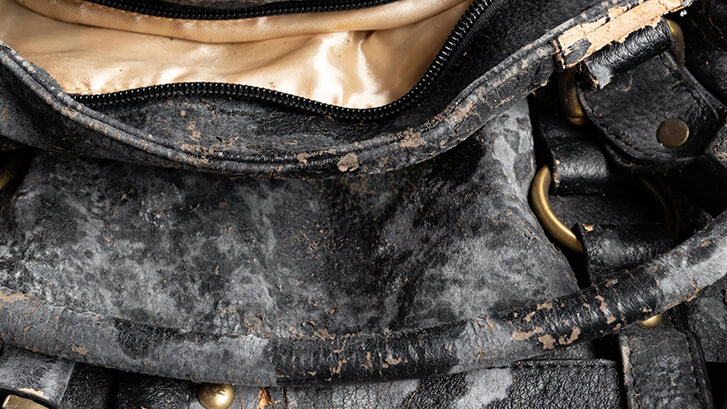Mold on leather can be frustrating, especially when it affects items you use regularly, like shoes, gloves, or jackets. When it comes to removing mold from leather, acting quickly and using the right methods is essential to prevent long-term damage. Mold develops when leather stays in damp, poorly ventilated spaces, and once it appears, it doesn’t go away on its own. Instead of replacing your item, you can clean and restore it safely using common supplies and proper techniques.
This guide covers how to remove decay effectively, prevent it from coming back, and maintain the quality of your hide for years. If you’re unsure where to start or what works best, this step-by-step approach will make the process easier and more efficient.
What Causes Mold on Leather?
Excess Humidity in Storage Areas
High moisture levels in the air create the ideal environment for mold to grow on hides, especially in closed spaces.
Poor Air Circulation Around Leather Items
Lack of ventilation in closets, drawers, or storage boxes traps moisture and heat; this accelerates mold growth on leather surfaces.
Leather’s Natural Porosity and Oil Content
Hide retains moisture and organic oils that mold spores feed on, making untreated or uncleaned leather especially vulnerable.
Storing Leather While It’s Still Damp
Putting hidden items away while they are wet or sweaty leads to internal moisture buildup: a key trigger for mold formation.
Long-Term Storage in Dark or Sealed Spaces
Mold thrives in darkness: storing leather in closed containers or dim closets without airflow increases the risk significantly.
How to Clean Mold off Leather: A Step-by-Step Method
Follow these structured steps for getting mold out of leather by using the right material.
Materials You’ll Need:
- Rubbing alcohol or white vinegar
- Soft, lint-free cloths
- Mild soap or hide cleaner
- Soft-bristled brush
- Conditioner
- Water
- Vacuum cleaner (optional)
Step 1: Prepare a Cleaning Solution
Mix equal parts of water and either rubbing alcohol or white vinegar: this will act as your mold-killing base.
Step 2: Test on a Small Area
Always test the cleaning solution on a hidden area first: this helps avoid discoloration or damage to the material.
Step 3: Clean the Mold
Dampen a clean cloth with the solution and gently wipe the decayed surface: use circular motions and avoid scrubbing aggressively.
Step 4: Dry the Hide
Pat the surface dry using a clean towel, then let the item air dry in a well-ventilated space, away from heat or sunlight.
Step 5: Condition the Leather
Once fully dry, apply conditioner evenly: this restores flexibility and keeps the surface from drying or cracking.
Mold on Leather Jacket or Shoes: How to Treat Them Properly
If you notice mold on a hide item, focus on seams, underarms, and lining: these areas trap sweat and moisture, encouraging decay. Use a soft brush to reach deep folds and narrow corners where it tends to hide. For shoes, remove laces and insoles if possible: clean them separately using the same vinegar or alcohol mix.
After cleaning, let everything dry in a shaded, well-aired place, and apply conditioner once the hide feels fully dry to the touch.
Types of Mold on Leather
The most common include white fuzz, green patches, or black dots.
- White mold often appears first and usually wipes off easily.
- Green decay may indicate a deeper infestation.
- Black decay is aggressive and should be removed immediately.
Regardless of the color or type, all molds should be treated with care: delay in cleaning can cause long-term material damage.
Can You Use Baking Soda or Soap to Clean Mold?
Yes, baking soda works well to absorb moisture and odor from hide: it’s best for light decay cases.
- Step 1: Sprinkle baking soda over the decay area.
- Step 2: Let it sit for 20 minutes.
- Step 3: Vacuum gently to remove the residue.
- Step 4: Wipe any leftover powder with a damp cloth and mild soap, if needed.
If using soap, always choose a gentle formula: never soak the leather or use harsh chemicals that can cause fading or cracking.
Vinegar vs. Alcohol: Which Is Better for Mold Removal?
Both solutions are effective when getting mold out of leather, but the choice depends on the type and the severity of decay.
- Rubbing alcohol is a strong disinfectant that dries quickly and works well on thick or dark mold patches.
- White vinegar is a natural, milder acid that removes odor and helps prevent future decay and growth, especially on delicate leather.
Use either option diluted with water, and always condition the leather afterward to prevent drying or stiffening.
Preventing Mold on Leather: Storage and Maintenance Tips
After cleaning, it’s important to keep decay from coming back by following smart care and storage practices.
- Store in a dry, well-ventilated space: avoid basements, plastic bags, or sealed boxes that trap humidity.
- Avoid airtight storage: leather needs to breathe to stay healthy and mold-free.
- Use silica gel packs or dehumidifiers: these absorb moisture and lower the chances of mold growth in humid environments.
- Wipe down items monthly: a dry cloth helps remove surface dust and moisture that decay thrives on.
- Condition leather regularly: every few months, apply a conditioner to keep it soft and prevent cracking or moisture buildup.
Conclusion
Getting mold out of leather requires the right tools, quick action, and proper maintenance to protect the material and extend its life. By cleaning decay safely and storing hide correctly, you can preserve the look and durability of your favorite items without needing costly replacements.


